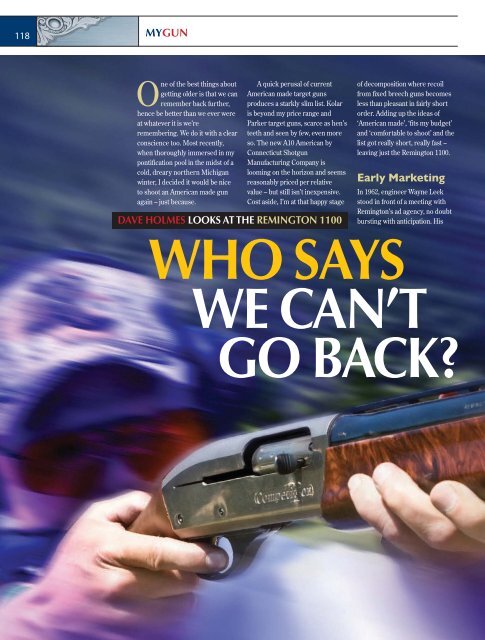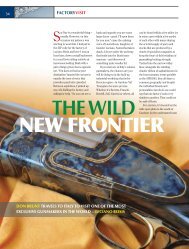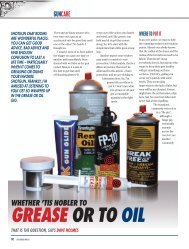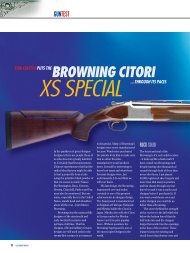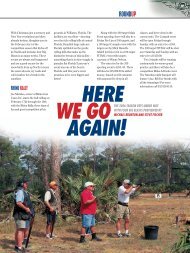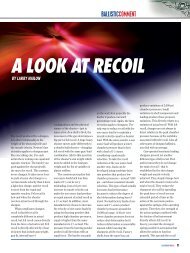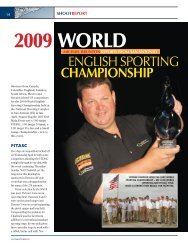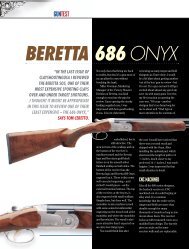Remington 1100:Layout 1 - Clay Shooting USA
Remington 1100:Layout 1 - Clay Shooting USA
Remington 1100:Layout 1 - Clay Shooting USA
- No tags were found...
Create successful ePaper yourself
Turn your PDF publications into a flip-book with our unique Google optimized e-Paper software.
118 MYGUNOne of the best things aboutgetting older is that we canremember back further,hence be better than we ever wereat whatever it is we’reremembering. We do it with a clearconscience too. Most recently,when thoroughly immersed in mypontification pool in the midst of acold, dreary northern Michiganwinter, I decided it would be niceto shoot an American made gunagain – just because.A quick perusal of currentAmerican made target gunsproduces a starkly slim list. Kolaris beyond my price range andParker target guns, scarce as hen’steeth and seen by few, even moreso. The new A10 American byConnecticut ShotgunManufacturing Company islooming on the horizon and seemsreasonably priced per relativevalue – but still isn’t inexpensive.Cost aside, I’m at that happy stageDAVE HOLMES LOOKS AT THE REMINGTON <strong>1100</strong>of decomposition where recoilfrom fixed breech guns becomesless than pleasant in fairly shortorder. Adding up the ideas of‘American made’, ‘fits my budget’and ‘comfortable to shoot’ and thelist got really short, really fast –leaving just the <strong>Remington</strong> <strong>1100</strong>.Early MarketingIn 1962, engineer Wayne Leekstood in front of a meeting with<strong>Remington</strong>’s ad agency, no doubtbursting with anticipation. HisWHO SAYSWE CAN’TGO BACK?
120MYGUNteam’s work was about to meet theworld. He ushered in a new era ofshotgunning when he told theassembled multitude that the newModel <strong>1100</strong> was going torevolutionize shotgun shooting.Forty-eight years later, with overfour million produced and moremajor target shooting wins underits belt than any other semi-autowill likely ever see, it would bepretty tough to argue the accuracyof his statement. While many of the<strong>1100</strong>s wins came on trap and skeetfields (before sporting clays was),our younger readers need tounderstand that the <strong>1100</strong> was thegun other manufacturers tried toemulate for many years. DuncanLawton (England) won the WorldFITASC Championship with a<strong>1100</strong>. Dan Carlisle shot one ininternational competition. LeoHarrison and Daro Handy shot trapfor a looong time with <strong>1100</strong>s. The<strong>Remington</strong> offering was top dog.I remember when the <strong>1100</strong> adshit. I looked longingly at the linesand devoured the ‘propaganda’.But those were different times.The difference in price betweenthe 870 and the <strong>1100</strong> was amountain this farm boy couldn’tclimb. I didn’t see Dad standinganywhere with his hand in hispocket either. (Truth be told, backthen, there was nothing I couldn’tdo with my 870, anyway.)My first <strong>1100</strong>, a .410, came alongsomewhere around 1970. I learneda valuable lesson with that gun,which worked just fine and was anabsolute joy to shoot. The lessonwas that I never wanted to reload.410 shells again. I haven’t either!Fast forward twenty someyears and I was reading about thisnew ‘sporting clays’ game – and Iliked what I read. I had an 11-87<strong>Remington</strong> field gun but thoughtthe new <strong>Remington</strong> Sporting <strong>Clay</strong>sgun would have to be better. It was,after all, a sporting clays gun. Itwas an interesting experience.The gun shot 10-12 inches tothe right. Some of you mayremember that <strong>Remington</strong> hadpast problems with choke tubeinstallation and point of impact wasnot to be taken for granted. Thereplacement 30" barrel was only28" long, but the choke tubes werein straight and it shot straight – soI decided 28 was more than closeenough to 30.11-87s of that period werehaving problems with the pistonsand piston seals breaking. I tried tokeep three sets on hand, alongwith a small collection of ‘O’ rings.My gun functioned fine for 340(I counted) shells, but soon startedhanging up. The Sporter receivereventually went south when a shelldetonated. There was nothing toindicate the gun was at fault, but Idecided to move on to the thennew Browning Gold. My autoodyssey continued to the Beretta391s. I’ve shot them ever sincethey came out, quite literally, sinceI was at the writer conferencewhen the first box was opened. I likeautos – I’ve lost too much hearingto be troubled by the cycling noiseand love the felt recoil reduction.<strong>1100</strong> CompetitionThe <strong>1100</strong> Competition has beenaround for about five years. Itaddresses concerns with cyclingissues by coating the receiver andaction bar with a nickel-Teflonfinish to increase lubricity. A new,one-piece piston/piston seal isunder the ‘hood’. The stock sports anew checkering pattern. Other thanthat, it looks pretty much like thegun Wayne Leek brought out inthat 1962 sales meeting – and thatain’t a bad thing. While lighter fieldguns from other makers have beenjustifiably well-received, and thereare more versatile gas systems innewer guns, the 8 plus pound <strong>1100</strong>is still competent (the extra weighteven desirable for target purposes).The Competition’s30" (30" only) barrelsports an advertised andmeasured dead-on .735bore with a long forcingcone that ends just shortof the gas ports. All up,the barrel weighs 2 lbs 12.6 oz.That’s sufficient to give the gun aweight forward bias – some mightterm it a bit muzzle heavy. (By wayof comparison, a 30" fixed-chokefield barrel weighs 2 lbs 8 oz.) Lessobvious are the gas ports.According to information I read,field and trap barrels have .079ports, fixed choke skeet guns .086.The Competition barrel sports .094ports and the shooter is limited to3 1 /4 dram equivalent loads.Ribs on the Competitionbarrels are .360 wide on both ends.Earlier ones have a surface that isquite similar to, if not technically,knurling. They sport a mid-beadand a delightfully small (as incould pass for a mid-bead) whitefront sight. Later ribs have aradiused cut on the surface, midbeadand a 1 /8" white front bead.The front bead does not have theblocky Bradley type base. Overallgun weight out of the box was arecoil dampening 8 lbs 10 oz.The <strong>1100</strong>’s five choke tubes are2 3 /4" overall with an 11 /16 extendedportion. The tubes measured deadnuts on for what one would expectgiven the designation: Skeet/.005,IC/.010, Lt Mod/.015, Mod/.020and Full/.030. The tubes arenotched for use with a wrench –though I haven’t found the wrenchnecessary.The Competition model comeswith B grade wood. It might notbe stunning, but I would havebeen happy to get it on any gunI’ve ever pulled out of a box. Stockdimensions are a measured1 5 /8" x 2 1 /4", with a 14" LOP and nocast or offset. A Limbsaver recoilpad brings up the rear. The finishis a high gloss poly, quite slick andcomfortable on the face. It showsthe grain of the stock in finefashion. Listed retail price is $1692,but they can certainly be found forless – in the $1200 range fromsome vendors on the internet.My GunI got the <strong>1100</strong> at the end ofDecember, an absolutelyridiculous time to get a newshotgun in Michigan, especially asemi-auto, if you are a reloader likeme. Snow and cold create lots ofproblems for equipment andshooters. On the other hand, if itworks in Mother Nature’s deepfreeze, it should work all year!CLAYSHOOTING<strong>USA</strong>
122 MYGUNI did have a bit of difficultygetting the gun together out of thebox. For those who haven’t dealtwith an <strong>1100</strong>, the usual process isto line up the bolt and bolt carrierwith the receiver, reach under thegun, raise the lifter slightly,depress the shell latch located onthe right side of the receiver andslide the bolt in – a piece of cake.What I eventually discovered, afterstrenuously doubting both mymemory and IQ, is that I had to getmy finger up and in on the tip ofthe shell latch to get it depressedsufficiently to slide the bolt carrierpast it. Once that wasaccomplished, the gun wenttogether with typical <strong>1100</strong> ease.Next up I shot every box ofodds and ends shells I had sittingaround. One Winchester Universaldidn’t eject as the bolt locked open.Most everything else worked – butwhen shells don’t work in an auto,one is wise to accept it and moveon rather than proverbially beatingone’s head against the wall.I was most curious to see howthe <strong>1100</strong> Competition’s nickel-Teflon coating would handle crud.My minimum standard was thatthe <strong>1100</strong> had to at least run reliablythrough a long weekend’sshooting without cleaning.<strong>Shooting</strong> the <strong>1100</strong> wet andcleaning after a day’s shooting onlytakes a couple of Kleenex, a littleCLP and a few minutes to wipe offthe <strong>1100</strong>’s gas system. Nospanners, scrapers or disassemblyof gas system components isrequired. I haven’t found anothergas gun easier to disassemble andclean than the Competition.CompetitionOutingThe first shoot with theCompetition came shortly afterbattling the gun to get it together.Knowing the gun was clean, I leftall my tools at home. I never dothat. Duh! Fourteen degrees,fifteen mile an hour breeze, firststation, first target – click. I headedto the clubhouse to have a lookinside with absolutely no clue whatthe problem was. I had to scour theclubhouse to come up withsomething borderline adequate todrive the pins out of the receiver tocheck the trigger group.The pins wouldn’t budge. Afterdriving two hours to shoot and nothaving brought another gun, I didwhat anyone would do. I hit thepins harder and harder until theyfinally popped out. The triggergroup was functioning perfectlyand everything else was as itshould have been. Reassembly wasequally perplexing, but finallyaccomplished. I shot the courseand the gun functioned perfectly.I’m still scratching my head overwhat happened, but 6,000 roundslater, I’ve had zero subsequentproblems and have total faith in thegun.In the course of prepping forthis article, I emailed <strong>Remington</strong> alist of questions I had and haveheard others bring up on variousoccasions. One was about thepossibility of adding stockadjustment shims to the package,ala just about every othermanufacturer on the face of theplanet. I received what I consideredto be a corporate response aboutthe exhaustive study done todetermine the perfect dimensionsfound on <strong>Remington</strong> stocks. Nodoubt the study was completedway back since the stockdimensions haven’t changed fordecades. Junior high kids are tallernow than my senior class was backwhen, so are those dimensions stillperfect? The drop figures are finefor a fixed comb, but even if we skipover the utility of a shim system,the 14" LOP simply needs to bestretched a bit to be a simple fit formany shooters today.<strong>Remington</strong>’s ‘perfect’ stockdimensions weren’t perfect for me,but neither are any other out-ofthe-boxgun’s. I’ve got to havesome offset. It ain’t optional. Thefactory stock, with its slim comb,will work for shooters who needmarginal offset, but for those of theprominent jaw clan, there is nowood to work with. The adjustablecomb model has been droppedfrom the line up this year. Options?Fortunately, I was working withFITASKI stocks when the <strong>1100</strong>found its way in the door. A littletinkering with FITASKI’sadjustable comb, add a couplewashers to adjust the pitch and lifewas much better.A second FITASKI benefit, inmy estimation, was that the addedweight of the stock took themuzzle heavy feel out of the gun.Total gun weight was a balanced9 1 /2 pounds. Recoil is ridiculouslymild compared to an 8 1 /4 poundover under. I have RA in myshoulders and neck and yet I canshoot the <strong>1100</strong> with my 7 /8 s ounce,1300 fps reloads until the cowscome home – with no ill effects.ReliabilitySporting shooters have longlooked with slight contempt at the<strong>1100</strong>. Few (no?) <strong>Remington</strong>s areseen at major sporting shootswhere the 391 is the king, queenand usually the prince and princesstoo. Why? Possibly quality control.Reliability has also taken a few hitsover the years. The ‘O’ rings usedin the gas assembly have gottenbad press. I made sure I hadspares early on, based on myearlier experience. Of course, thatmeans the original is still in greatshape and will probably last until Imisplace the replacements. Thenew one piece piston/seal hasworked just fine. There are thoseon the internet who claim the oldtwo piece system works better, butI haven’t seen how that would bepossible with this gun, since it hasfunctioned flawlessly since the‘mystery’ incident at its first shoot.I have to wonder what thereliability reputation of <strong>1100</strong> targetguns would be today if shooters inearlier decades had been savvyenough to do what we do now –consider preventative maintenance(a routine part of the game).Springs take a beating in an auto.How many <strong>1100</strong> receivers wouldstill be up and running today if wehad been smart enough in the ’60s,’70s and ’80s to replace the actionsprings and kept that recoilbeating from being transferred tothe receiver? How many reports offunctioning problems would neverhave been uttered? Leo Harrisontold me he had never replaced thespring while shooting a bazillionrounds at trap. Bruce Buck wroteof wearing out <strong>1100</strong>s in his skeetshooting days, but also concedesCLAYSHOOTING<strong>USA</strong>
124 MYGUNthat he didn’t replace the springs,either. Nobody did ‘back in thosedays’.I found a credible internetaccount of an <strong>1100</strong> that lasted for aquarter-million shells, albeit with abit of nurturing. There is anexcellent ‘sticky’ post onwww.shotgunworld.com under the“I Love My <strong>Remington</strong>” thread,that offers a myriad of tips onkeeping the <strong>1100</strong> series up andrunning. One of the moreinteresting was the use of lightgrease to lube action parts ratherthan the liquids we commonly use.The grease gets credit for killingvibration in the gun. (By the way,grease works fine, even in coldweather – I used STOS andShooters Choice.) The informationon the thread comes from<strong>Remington</strong> employees, gunsmithsand long-time <strong>Remington</strong> shooters.It’s well worth the read.Get a group of experiencedshooters together and ask them todescribe their idea of the perfectclays auto. I’ll bet 8 of 10 will list asteel receiver in their design plans.The <strong>1100</strong> is the only currentlyproduced auto that offers one.The <strong>1100</strong> receiver starts out as an8 1 /2 pound chunk of steel. Itends up 1.340 inches wide and2.370 inches high. That’s slimmerand trimmer than anything else atmy house that says 12 gauge on it.In fact, it’s slightly slimmer thanthe receiver on my 20 gauge 391 –that bit of research kinda’surprised me too!I noticed the slimness of thereceiver the first time I mountedthe gun. I’m a one-eyed shooterand was immediately aware of howmuch less gun there was ‘in theway’. Two-eyed shooters probablywouldn’t notice the difference sographically, but I sure did – and Iliked the expanded ‘field of view’.The receiver color isn’t quitesilver and I don’t know what to callit, but it’s a light color that doesn’tstand out when the gun is mounted.That’s another positive little touch.This <strong>1100</strong> trigger assembly willswap out with any other <strong>1100</strong>trigger. It does have a nice touchadded over earlier models. Thebolt release, located on the shelllifter, is extended. This release hasto be depressed to load the gun.The shorter ones could be a bit ofa small target to find sometimes –but this new one makes the <strong>1100</strong>incredibly easy and quick to load –One aspect of the <strong>1100</strong> worthmentioning is the ample partssupply, most quite reasonablypriced, available throughout mostof the country or on line.There’s also plenty of sparebarrels to be found at prices towarm the heart. I walked into thelocal gun shop and walked out witha 30" field barrel that had beenshot very little for $150. Barrelscan be found on the internetalmost daily for similar prices. Newbarrels are listed at the CountryI would like to see <strong>Remington</strong> focus someattention on the <strong>1100</strong> as a target gun.drop one in the chamber andshove the other in the tube withthe can’t miss extended release.There isn’t a simpler system.The trigger pull was like anyauto – less than stellar. I spentabout 15 minutes polishing partsand moved this trigger from thebasement to the first floor. There isstill room for improvement, but it’snow OK. The trigger is the samenarrow design that has been usedsince before Moses had to shave.It’s one area I feel would be quiteeasy to generate some designimprovement, something widerwith a more comfortable curve toit. At the very least, <strong>Remington</strong>should explore Browning’s overunder approach of offering factorytrigger shoes. (Tyler still makestrigger shoes for the <strong>1100</strong>.)Store at www.remington.com andare quite reasonably pricedcompared to some other models.The <strong>1100</strong>’s gas system hasbeen surpassed – some will say it isoutdated, but show me anothercurrent shotgun that has been onthe market for 47 years? There’s athin line between an outdateddesign and a classic functionaldesign, as is witnessed by theModel 70 Winchester or a 1911Colt pistol. Both are designs thathave been superseded, but nobodydoubts their functionality. Thesimplicity that made the <strong>1100</strong> aninstant hit in 1963 is the samesimplicity that keeps it quietlycompetitive today.The maligned-in-sportingcircles<strong>1100</strong> is still spoken of fondlyin trap shooting circles. I’ve seencomments alluding to thatfavorable opinion stemming fromtrap shooters only having to shootonce. However, my 6000 roundsthrough the <strong>1100</strong> haven’t shown anissue with second shot reliability.I’ve corresponded with another<strong>1100</strong> Competition shooter who hasabout 40,000 rounds through his.He has had zero problems withcycling or parts and is still usingthe original O-ring. He chose the<strong>1100</strong> because he liked the feelbetter than any other gun – andhas found no reason to change.My Wish ListIt’s no secret <strong>Remington</strong> hasstruggled to introduce a newmodel with market appeal. I wouldlike to see them focus someattention on the <strong>1100</strong> as a sportingtarget gun. Seems everyone inHollywood that has been around aslong as the <strong>1100</strong> is getting a facelift, so why not? Ratchet up thequality control and give it the newtrigger I mentioned. A true targetstock rather than a take off on thefield stock would be welcomed, aswould a shim system, redesignedgrip, added LOP and palm swell – areal target stock. With that, I can’tfind a reason why the <strong>1100</strong>Competition couldn’t be acontender on the sporting field foryears to come. With the currenttrend towards light, lighter,lightest, the weight of the <strong>1100</strong> isgoing to keep it a soft shooter,always a welcome feature. Thesimplicity that made the <strong>1100</strong> aninstant hit in 1963 is the samesimplicity that can keep it quietlycompetitive for years to come.Simply put, the <strong>1100</strong>Competition is a better gun thanwe thought and the <strong>1100</strong> designworthy of more respect than itgets. This gun is capable andcompetent – and red, white andblue through and through. ■CLAYSHOOTING<strong>USA</strong>


